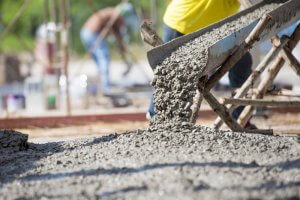The Advantages of Pervious Concrete

Pervious concrete is one of the most innovative materials in the construction industry today. It’s not only highly resistant but respects the environment. It also comes with a whole array of other advantages which we’ll discuss in greater detail later on. By the end of this article, you’ll understand why this material is destined to be one of the star sustainable building materials of the future.
If you haven’t heard of pervious concrete yet, now’s the time to find out all about it. Before we take a look at its main advantages, we want to discuss some of the different uses of this material. Few alternatives have so many beneficial properties and are so good for the planet.
The uses of pervious concrete

Pervious concrete is a material that’s mainly used in construction. It’s normally used for building roads, sidewalks, streets, and public spaces. Given the wide variety of finishes available, it can produce great results and is a fantastic example of how you don’t need to compromise on aesthetics to help create a more eco-friendly world.
It’s also used for paving underground parking garages. Due to its great ability to allow water to pass through it, it’s an effective way to prevent waterlogging and similar issues. If your garage is prone to these types of problems, pervious concrete is the solution.
Although it might be less common, in some cases, pervious concrete is also used in interiors, mainly in eco-friendly homes that are designed to respect and care for the environment.
The benefits of pervious concrete
Pervious concrete has a huge number of benefits. This is one of the many reasons it’s gaining so much popularity and is increasingly being used in a wide variety of situations. Here are some of the most important advantages to keep in mind:
Protect the environment

Without a doubt, the key feature of pervious concrete is its ability to help fight climate change. This is a problem that affects all of us and has serious consequences for the planet, as well as animals and human beings. These types of new materials are a key part of fighting this devastating issue.
Pervious concrete has the power to filter harmful gases emitted by cars. This is important, as it prevents the contamination of nearby areas. Another great quality is that, when used in green areas, it allows both water and air to pass through, promoting the growth of vegetation.
Avoid flooding

As the name suggests, pervious concrete is pervious or permeable. This means that it doesn’t let water build-up. When it comes to roads, public parks and streets, this is an extremely useful quality that prevents waterlogging and flooding.
After heavy rainfall, it’s common for some areas to flood, often leaving them inaccessible. In these cases, people often have to wait for hours or even days for the excess water to disappear and normal travel conditions to resume. This usually occurs in wetter climates, where rainfall and humidity are higher.
However, thanks to pervious concrete, this problem can be avoided. Roads and streets remain puddle free, increasing comfort and safety. We’ve all found ourselves faced with huge puddles in our path on more than one occasion.
Driver safety

Safety is fundamental when it comes to choosing the materials used on our roads. While it’s true that the physical and mechanical properties of the materials must also be taken into account, the safety of drivers is paramount.
In this case, pervious concrete more than meets public safety needs. Thanks to its porosity, it’s perfect for allowing cars to grip properly without slipping.
During periods of heavy rainfall, drivers can avoid the dreaded aquaplaning. This problem occurs when water builds up on roads. A road that’s not porous enough or doesn’t allow sufficient water drainage allows puddles to form. When tires hit these puddles, they’re unable to grip the surface, causing the car to skid.








